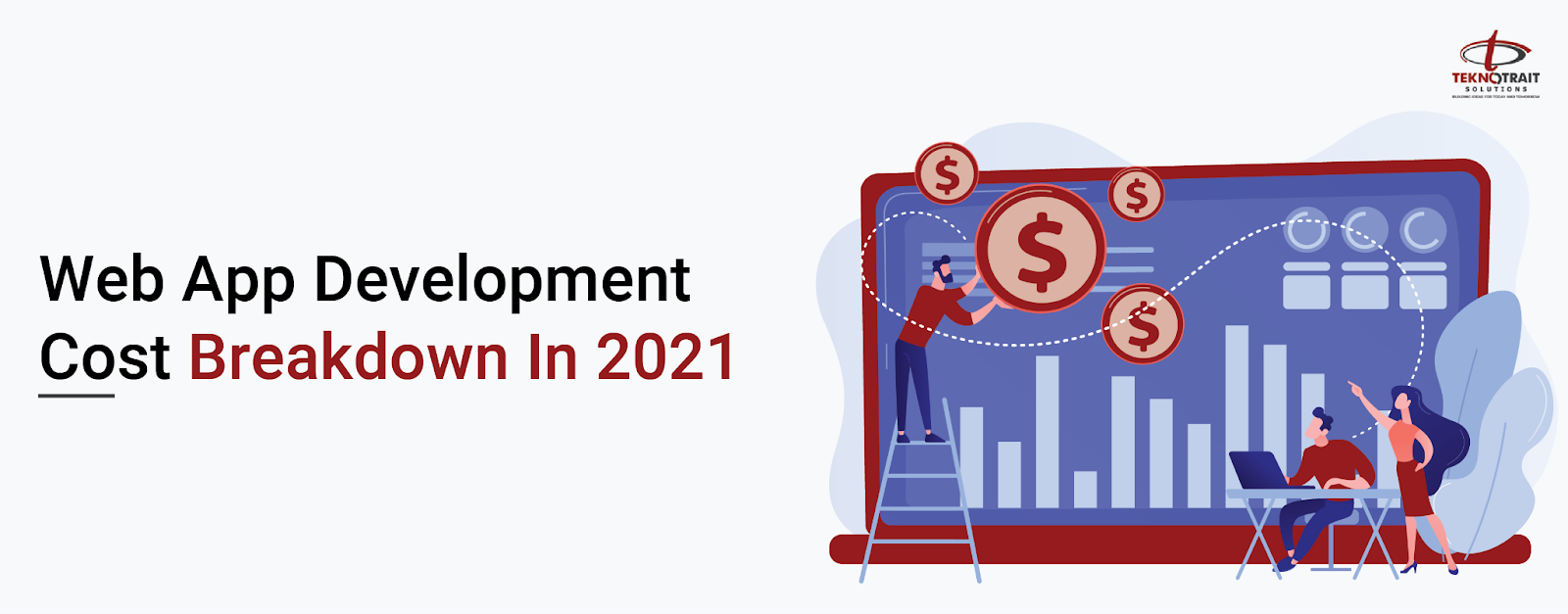
Web App Development Cost Breakdown In 2022
In today’s world, web applications have become a vital aspect of a business.
Businesses can now develop and become simpler, as well as achieve their goals much faster, by utilizing web applications. Such applications could really allow you to identify a large number of clients and customers at the same time.
Businesses are quickly adopting this facet of the internet by developing web applications with the assistance of development teams – to accomplish their business goals.
So, how much would it cost to build a web app? It goes without saying that this is one of the first questions that need to be addressed when an organization or development team embarks on an app development project.
To begin with, the cost of developing an app is difficult to estimate. And the cost could vary depending on factors such as the Type of Web App, Required Features, Complexity of Functionality, and Design of the app.
Let’s go through the details.
Types of Web Applications :
The world of web applications is very considerate because it offers the finest solutions for a wide range of businesses.
The various types of web apps are listed below.
Static Web Application :
A static web application could cost anywhere between $750 and $2,500 to develop. The vast difference in price is mainly due to the app’s level of complexity. The larger the project, the more resources, and expertise would be required.
As a result, the price rises. These apps, on the other hand, are simple to create and use popular programming languages such as HTML and CSS.
The primary objective of these web apps is to provide the consumers with an online brochure or to display a portfolio. When the world returns to normalcy in 2021, the static web application could be used as the primary reference point for understanding any business’s offerings.
Thus, resources and maintenance will be the two major factors that could influence the overall cost of app development.
Web Portal :
The overall time to develop a web portal could range from 2 to 5 weeks. Portals are typically designed using pre-defined templates, which make them easier to develop. Widgets, additional pages, media, and other elements could be considered as portals.
A few immersive features could be employed to keep your audience interacted and informed.
The cost of developing web portals ranges between $3000 to $10000, depending on the complexity as discussed before.
Dynamic Web App :
Dynamic web applications could be tricky to develop. These are built to support data based on the customer’s inclinations towards your product or service and may alter the complexion slightly depending on the visitor’s location. These types of apps necessitate both coding and a deep understanding of HTML.
The cost of a dynamic web app development could range from $3500 to $7500, depending on all factors such as time, resources, people, and maintenance.
E-Commerce Web App :
The price of an E-commerce web application could start from $12,000. Some of the popular features of E-Comm apps include CMS, push notifications, email integration, payment gateways among others. E-commerce web applications make it simple to serve customers located all across the world.
Enterprise Web App :
A web app for an Enterprise Business could be both large and complex. The requirements could be challenging too. As a result, companies providing enterprise web app development services in 2021 may charge upwards of $100,000 to cover costs for R&D, Subject Matter Expertise, App Development, and application QA & Testing.
CMS Web App :
CMS web app development solutions are used by business owners who want to have more control over their website content. The content can be edited, removed, or added by the owners without any prior programming knowledge or expertise.
The price of developing a web app using CMS is entirely determined by the CMS software that you intend to use.
Top CMS solutions include :
1. WordPress :
WordPress allows for the creation of simple web apps that can be enhanced using a variety of plug-ins. Web app development using WordPress is usually the first choice of preference for startup owners or entrepreneurs due to the ease of customization offered, theme selection, and so on. You could get a web app ready using WordPress for as little as $1000, to begin with.
2. Drupal :
Drupal aids in the development of strategically designed web apps. The responsiveness, appeal, functionalities, and scalability of the application stand out while developing the app through Drupal. A typical Drupal web app development project could start from $8,000.
3. Magento :
Magento is an open-source tool that aids in the development of search engine optimized apps, with features such as payment integration, catalog management, and so on. Magento is a good option for those who want to reach out to shopping enthusiasts, as it very smoothly accommodates E-Commerce requirements. You could expect to spend around $25,000 to begin developing your web app on Magento.
It is prudent to understand the cost of developing a web application, especially if you desire one but lack the technical know-how of developing one. It is critical and useful to ensure that every penny values and realizes your ultimate business solution. Knowing about the cost would’ve allowed you to plan and manage your finances effectively.
However, when you approach a developer or a web app development company for their services, they would be unable to provide you with an exact quote. This is because costing stems from the fact that web application development is a multi-stage process that necessitates a significant amount of effort and time.
Every project is a unique undertaking with unique tools, approaches, and development team composition. As a result, it contains variables that make it difficult to cost the process precisely.
The Development Process for a Web App :
If you are planning to create a web-based app, it would be a good idea to sit down and figure out what the entire process involves and why you would be paying that specific amount for an activity. Regardless of the approach used, the strategy could involve intense labor. Furthermore, the stages necessitate the participation of a wide range of qualified specialists.
So, the go-to strategy typically consists of five stages, which include Requirement Gathering or Analysis, Design, Prototyping, App Development, and Software Testing, as well as Introducing the app or Launching it in the marketplace.
a. Requirement Gathering :
This phase involves the collection and analysis of requirements. The firm’s team of analysts organize multiple sessions with the clients and business stakeholders to ask a lot of questions about the desired features, the business’s vision, goals, among others. Throughout the project, business analysts serve as liaisons between the development team and the stakeholders. A prototype is created during this stage, in addition to wireframes, user stories, and use cases. Also, the scope and functionality documentation are prepared in this phase.
b. Interface Design & Development :
This is where all the Magic happens! The Designers are tasked with designing the interface of the application. All the visual elements of the application are designed in this phase, which are of top-notch quality – keeping the User Experience in mind. The idea here is to ensure that the application reflects and expresses the identity of the company or product. This also happens to be the most visible stage of the development life cycle as this is where the app is actually brought to life. It includes both the application’s front-end and back-end components. Meanwhile, the development team continues to code simultaneously while also running unit tests to ensure that even the modest of testable code is running as expected.
c. Software Testing :
Next, the QA engineers perform functional and UI/UX testing in addition to several types of manual and automated tests during this stage. The User Acceptance Testing(UAT), which involves the intended app users, is performed as one of the final activities in this stage.
d. Launching Application & Maintenance :
The ultimate stage in the development lifecycle involves the product’s release. Load testing can be done here to determine how the app behaves under peak and normal load conditions.
Before running the final system test, the development team prepares the server and domain.
The successful completion of this test would then result in the app’s release. To execute all the stages successfully it is important to necessitate the use of various experts and tools.
As a result, it becomes tricky to accurately estimate the costs involved in each of the processes because each step could present you with a unique challenge. Hence, it is recommended to include a tolerance of “+/- 20%” with your initial estimate to avoid going significantly off the track with regards to initial budget plan.
Elements that have a say in Web App’s development Costs :
a. Scope Of Work :
This should be determined considering the important features of the web app along with the threshold and degree of effort required to develop them. Incorporating all the desirable features at once could be detrimental because it will lengthen and increase the development process and add significantly to the initial expense.
On the contrary, focusing on developing limited yet important features would significantly cut down the cost upfront as you can always add additional features and release them through regular app updates.
Here, developers would only need to focus on developing key features of the web app as per the current sprint, which would also allow the Test Engineers to test limited features of the app while being effective and sensitive to project timelines.
b. Business Domain :
Having a broad domain means getting more people to help you turn your idea into a reality. Furthermore, a popular domain would also ensure that you have a sizeable pool of resources to choose from and the costing would also get substantially scrutinized because of the heavy competition within the domain. You must keep in mind that any ordinary person can create an app, but the problem is their incompetence or sustainability.
c. Technical Difficulty :
Because of the varying levels of technical difficulty of the project, different features necessitate a wide range of skills. As a result, you will find some features that require standard operation in their implementation and thus cost less. Other features such as third-party integrations, could be more complex due to API usage, and could cost more.
d. Designing Of The Interface :
The urge for personalized designs for web app could prove to be a costly affair. It would require expert designers and programmers who would need to work tirelessly to make your design unique and functional, while also ensuring that your idea and identity are reflected in the brand. Front End Developers would need to create the app’s custom markup. Furthermore, stunning animations and effects, company logos, and the likes of it may consume more time and may cost more.
Additional costs may be incurred as a result of some specific design requirements from the client. When you consider the timelines required to create an app, the cost of web application development may vary.
A last minute addition to the requirement would warrant immediate attention and may cost you more because the developer’s team would have to devote more resources to the web app’s development process. It also constitutes increased risks and a greater need for efficacious supervision.
e. Development Complexity :
It is understandable that the cost of developing a web app rises with a rise in the app’s complexity. Because app development work is paid on an hourly basis, the time required is critical in determining the cost. Needless to say, complex applications take more time than simpler ones and hence the latter are less expensive.
A simple formula to determine cost is =
(app features * no of hours required for development) * per hour rate of the resource.
As a result, the overall cost is determined by the number of features and the number of hours required to develop each feature. The per hour rate is an intriguing factor in this formula.
f. Non-Functional Requirements :
Non-Functional requirements include diverse features that add to the app’s functionality. They include security, scalability, dependability, usability, and performance among other things. One critical non-functional requirement is the system’s ability to handle requests for each time unit. High-load systems are comparatively more expensive than low-load systems.
g. Developer Location :
The United States, Europe, and India are the world’s three major web application development hubs. Developers in these countries work at varying rates. App development rates in the United States range from $90 to $160 per hour; in Europe, rates range from $45 to $75 per hour; and in India, rates range from $15 to $65 per hour. No wonder companies from the US prefer offshore development, in which they communicate with a developer in India via email, Skype, and other means and get the job done at an economical cost.
Estimating the cost of developing a web app could be a difficult, if not impossible, task. However, by referring to these guidelines, we hope that you’d have better clarity the next time you plan to take on developing a Web App.
With this we conclude this topic while hoping that you have gained a fair understanding of the web app development costs and associated prices.
If you want to develop a web app feel absolutely free to get in touch with us.


